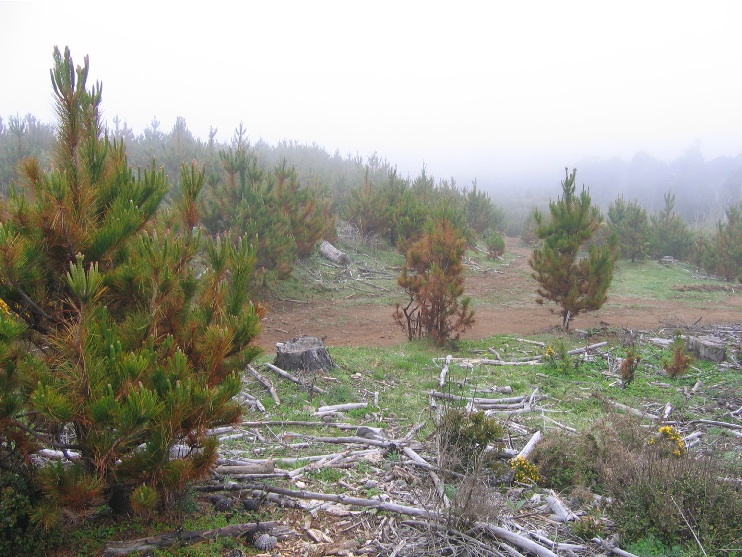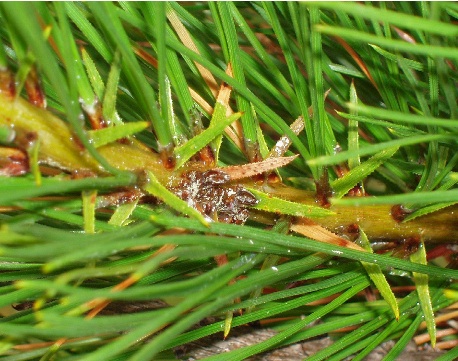PESTS AND DISEASES OF FORESTRY IN NEW ZEALAND
Needle blight in Chile
Scion is the leading provider of forest-related knowledge in New Zealand
Formerly known as the Forest Research Institute, Scion has been a leader in research relating to forest health for over 50 years. The Rotorua-based Crown Research Institute continues to provide science that will protect all forests from damage caused by insect pests, pathogens and weeds. The information presented below arises from these research activities.
From Forest Health News 179, December 2007.
(For more photos of DFP click here)
In mid-October 2007, Lindsay Bulman and Rebecca Ganley visited Chile to look at unusual symptoms on Pinus radiata foliage.
The visit was funded by the Forest Biosecurity Research Council and the Foundation for Research, Science and Technology. The symptoms were first noted in 2003 when fewer than 100 ha were affected. By 2006 symptoms were recorded over approximately 60 000 ha. The problem is named Daño Foliar del Pino (DFP), meaning damage to pine foliage.
Since early 2006 Scion pathologists have been in contact with Chilean researchers, who have carried out many studies on possible causes including looking for abiotic factors such as poor nutrition, solar radiation, ozone, and soil type, as well as pests and fungal pathogens. In early October 2007, Mike Wingfield from the Forestry and Agricultural Biotechnology Institute in South Africa announced that an undescribed species of Phytophthora had been isolated from symptomatic material growing in Chile; however, the association between the disease and Phytophthora or any fungal pathogen has not been proved. It is likely that DFP is has a complex aetiology, although interactions between DFP, pathogens, environment, and host are not yet well understood.
From a distance, affected trees appear similar to those affected by Cyclaneusma needle-cast. Foliage turns yellow, gold, and then brown and 1-year-old foliage is affected (Fig. 1). However, the resemblance ends there. Needles do not detach from branches as readily as those affected by Cyclaneusma and symptoms often start with a pale area at the base of the needle, accompanied by a black band.

typical of the location. Photo taken October 2007.

Another distinctive feature of DFP is the formation of resin at the point of connection between the needle fascicle and the branch. Lesions may form on young succulent tissue (Fig. 2), but tend not to form on old tissue or on branches of older trees. Sometimes a brown discoloration can be found in the cambium at the trace of a symptomatic needle.
In Chile, DFP is most severe on sites prone to prolonged periods of moisture through low cloud, mist, fog, or rain.
In New Zealand inspectors should be especially vigilant on sites with similar environments. DFP could well be a problem on such sites. The Forest Health Reference Laboratory at Scion is routinely testing all Pinus foliage with suspicious symptoms for Phytophthora spp. Protocols for testing have been developed and documented.
Molecular diagnostic tests specific for this species of Phytophthora are unavailable but are currently being developed overseas. Total DNA extracted from needles displaying DFP symptoms in Chile, collected during this latest visit and stored at Scion, will be used to test the reliability of any diagnostic tests developed. We have also written a field identification guide that has been sent out to forest health surveillance providers. Copies of this can be accessed at:
http://www.ensisjv.com/NewsEventsandPublications/ Publications/ResearchPublications/ ForestHealthandProtectionBulletins/tabid/314/Default. aspx
Through the visit, not only has our understanding of DFP increased, but communication with Chilean officials has been enhanced.
Scion and Servicio Agricola y Ganadero (SAG), the Government Department responsible for protecting Chile’s primary sector, are developing a Memorandum of Understanding.
Scion pathologists are maintaining close contact with SAG officials and keeping up-to-date with results of surveys and other research activities currently under way in Chile.
Lindsay Bulman and Rebecca Ganley
This information is intended for general interest only. It is not intended to be a substitute for specific specialist advice on any matter and should not be relied on for that purpose. Scion will not be liable for any direct, indirect, incidental, special, consequential or exemplary damages, loss of profits, or any other intangible losses that result from using the information provided on this site.
(Scion is the trading name of the New Zealand Forest Research Institute Limited.)

 Farm Forestry New Zealand
Farm Forestry New Zealand

